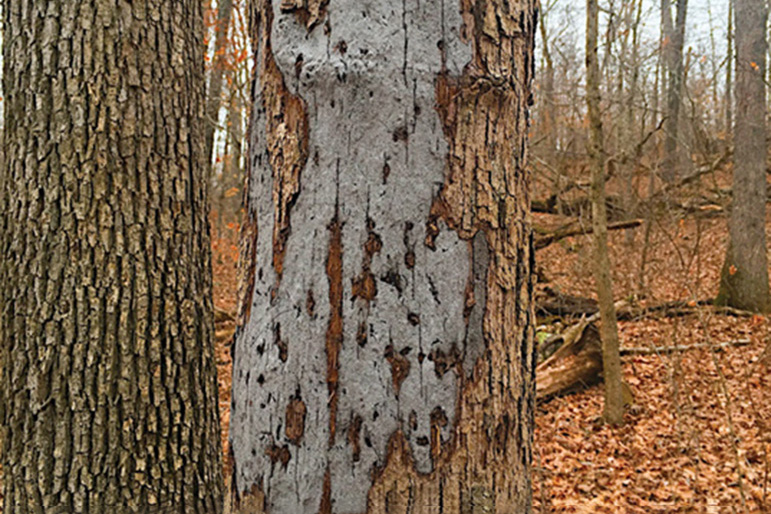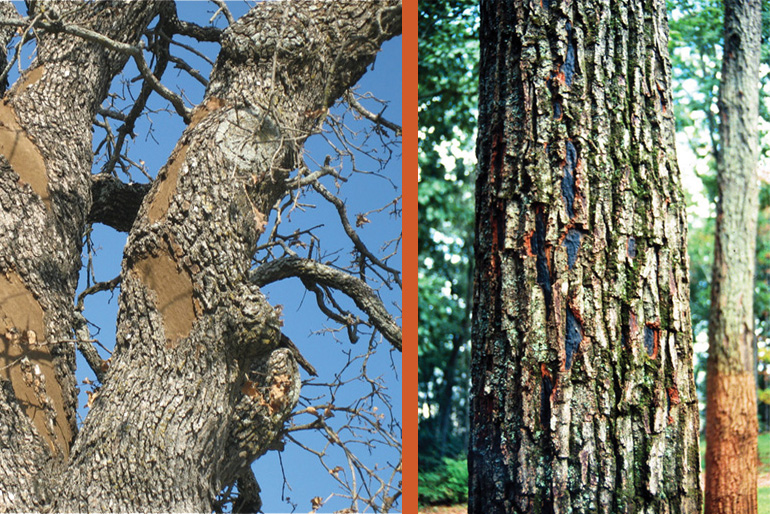

Hypoxylon canker is a disease that appears as a dead lesion on limbs, branches, and trunks of affected trees.
When a tree dies for any reason, many different fungi will start the rot cycle in the wood. This cycle is made up of rots that affect specific parts of the wood, and which start only after the tree is dead. It may take 10 years for a dead tree to start “falling apart” due to the internal rot that starts when the tree dies.
But other fungi can attack the tree while it is alive, thus starting the process of killing the tree. Hypoxylon canker is one such fungus. The fungus is considered a weak pathogen: it can germinate (start attacking) only if the tree’s defense system is weak; a healthy tree cannot be successfully attacked by Hypoxylon. When the tree’s defense is weak (low energy, it’s all about energy) and Hypoxylon canker is starting to colonize the tissues of the tree, it will travel down the tree’s cambium zone (a tissue layer that provides cells for plant growth). Because Hypoxylon clogs the pipe system of the tree, the tree dies at the point where the fungus starts. The fungus can then proceed to the roots and kill the entire tree.
There are two types of fungus: “white rot” and “brown rot.” White rot, such as Hypoxylon canker, attacks the lignin, the structural support system of wood. This targeted attack on the lignin causes the tree to “fall apart” in only two to three years.
In eastern Pennsylvania, including the Philadelphia area, the red oak (family) is the tree most affected by Hypoxylon canker. White oak (family), beech, and sugar maple may also be attacked, but all three combined do not suffer to the same extent as the red oak.
Clients often ask if dead wood must be pruned out of a tree. The answer is yes – and no. It depends on the species of tree; the size, location, and age of the dead wood; and what environmental factors (drought, rain, etc.) are affecting the tree at the time. In addition, a most important consideration is whether the tree has signs of Hypoxylon canker. If the canker is in the top of the tree, it may be possible to prune it out, but there is no “cure” for the tree other than excising the fungus. The only medicine is preventive care.
The Hypoxylon canker gives us one vehicle for correction: Advance care. Since the fungus is a secondary fungus, which can only attack a weak tree, the object is to keep the tree healthy. Watering the tree in an extreme drought, fertilizing the tree regularly every other year, mulching the root system, etc., can give the tree the best chance for surviving – or better yet, avoiding – the attack of Hypoxylon canker.
A final note: If a tree has been dead for more than two years, it should be considered extremely dangerous, and no one should climb it. If a crane cannot get to the tree, the homeowner will face a very real problem in terms of removal.
Please give us a call if you have any questions about your trees and shrubs or would like to schedule an appointment for us to walk your property.
We can work with you to preserve the precious trees on your property.

When heavy winds blow, major limbs — and sometimes entire trees — fall. The primary reason for this is poor structure, which results...

In the past 10 years, several significant pest and disease issues have become so common that we deal with them every day. Here...

Beech Leaf Disease (BLD) is emerging as the biggest threat to our trees since Emerald Ash Borer.
As we have communicated over the past...